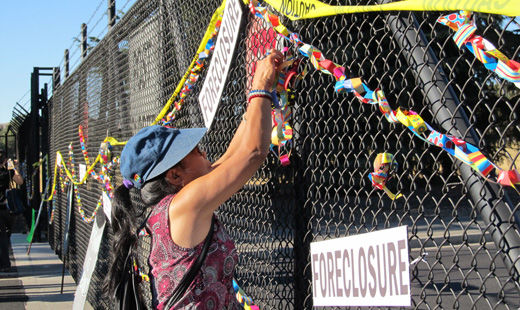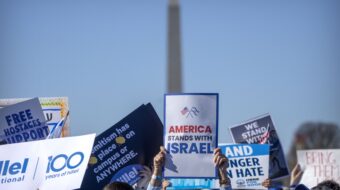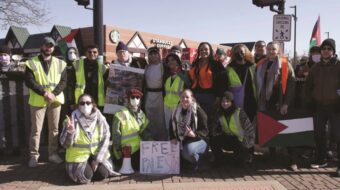
LIVERMORE, Calif. – Though more recent issues of ending the Afghanistan and Iraq wars and keeping the U.S. from engaging in new ones may make more headlines, the decades-old goal of winning worldwide complete nuclear disarmament remains an urgent peace movement concern which is supported by a strong majority of Americans.
That concern was foremost in the minds of some 200 protesters who gathered here Aug. 5 to mark the 67th anniversaries of the U.S. nuclear bombings of Hiroshima and Nagasaki.
Demonstrators gathered in a grassy park near the Lawrence Livermore National Laboratory – one of several facilities around the country designing and maintaining the U.S. nuclear arsenal – before marching to the lab’s gates to symbolically “Foreclose on the Bomb, Not the People,” hanging colorful plastic chains and locks across the fencing.
Speaking at the park, Tara Dorabji of Tri-Valley CAREs (Tri-Valley Communities against a Radioactive Environment) reminded the crowd that while they were among hundreds of thousands around the world commemorating the twin anniversaries, they also occupied a special place.
“Every nuclear weapon in the U.S. arsenal was created and designed by an employee of the University of California, either at this lab or at the sister lab in Los Alamos, N.M.,” she said. “So being here, and saying No to nuclear weapons, is being at the brain, the center of the complex.”
Michael Eisenscher, national coordinator of U.S. Labor against the War, pointed out that the U.S., which is the only country to use nuclear weapons in combat, today “maintains the capability to repeat the crime on an even greater scale … that could lead to the extinction of the human race and many other species.” He urged the U.S. government to “set an example for other nuclear powers” by committing to a national policy of demilitarizing U.S. foreign policy and achieving global nuclear disarmament “at the fastest possible pace.”
Among other speakers were Hiroshima A-bomb survivor Takashi Tanemori, who shared his heart-rending story of being orphaned by the bomb at age eight, Andy Lichterman of Western States Legal Foundation, and Natalia Mironova of Russia’s Movement for Nuclear Safety.
Later, outside the lab gates, four protesters were cited and released after committing nonviolent civil disobedience.
Protests around the country got off to an early start as three activists calling themselves “Transform Plowshares” slipped past four perimeter fences July 28 at the Y-12 nuclear facility at Oak Ridge, Tenn. They walked for two hours through a “use of deadly force authorized” area before reaching the newly built Highly-Enriched Uranium Manufacturing Facility deep within the complex. There they attached two banners to pillars of the building, stringing red crime tape between them.
The three – Sister Megan Rice, 82, Greg Boertje-Obed, 57, and Michael Walli, 63 – were arrested and charged with felony counts of vandalism and trespass. After several days’ detention, they were released pending their next court appearance on Aug. 9.
At a third national center, Los Alamos National Laboratory, protesters also held a weekend of actions. Slated to speak at an Aug. 5 rally was 48-year-old hunger striker Alaric Balibrera, one of about 30 anti-nuclear-weapons hunger strikers around the country.
Balibrera, who started his hunger strike July 16, on the 67th anniversary of the first atomic bomb test in Socorro County, N.M., told Albuquerque’s Journal North that his father had been documentarian at the lab and he grew up “watching the image of mushroom clouds projected on our living room wall.”
Besides the specter of nuclear annihilation, Balibrera said, he is concerned about the contamination that has killed untold numbers of uranium miners, nuclear weapons workers and people living downwind of nuclear activities.
Photo: Marilyn Bechtel/PW

MOST POPULAR TODAY

Zionist organizations leading campaign to stop ceasefire resolutions in D.C. area


High Court essentially bans demonstrations, freedom of assembly in Deep South

Afghanistan’s socialist years: The promising future killed off by U.S. imperialism

Communist Karol Cariola elected president of Chile’s legislature






Comments